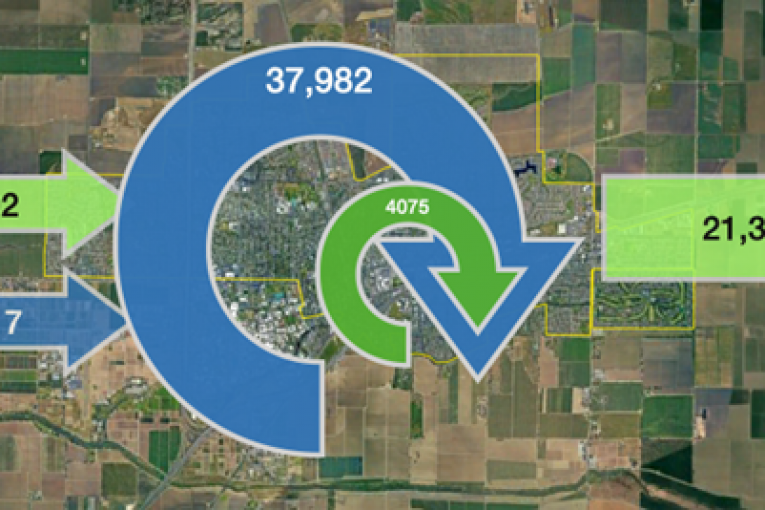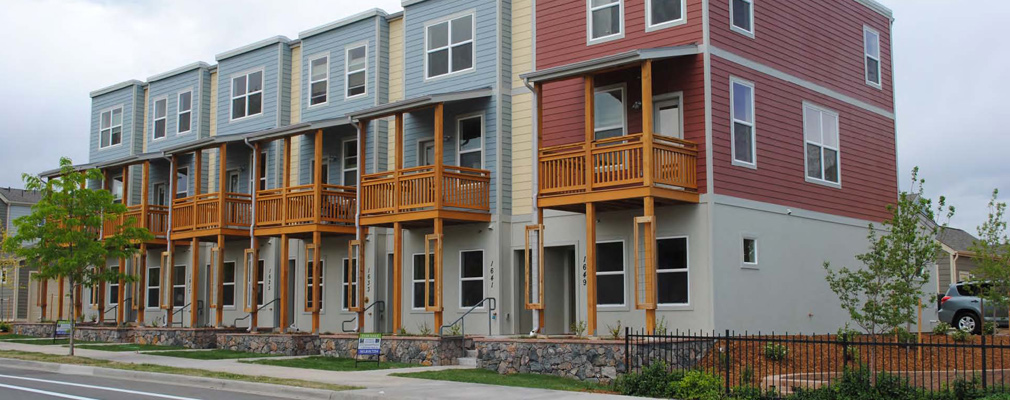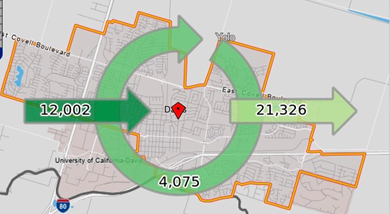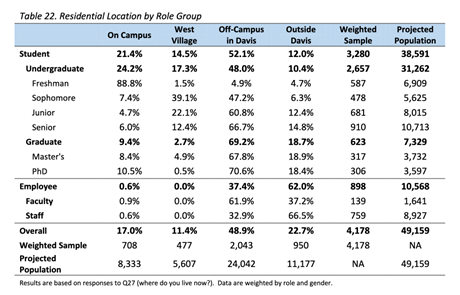

by Tim Keller
In this series of articles, I took a look at university towns in similar situations as Davis: Land grant and public research universities in geographically distinct cities where the university is the largest employer. My thesis was that the size of the university should be predictive of how big its attendant city should be, and indeed the data showed that such a relationship did exist: but it only told 60% of the story.
(Aside: After I published my last couple of commentaries, I have had a number of people suggest different variables I should consider, and who have corrections to some of the numbers listed. These suggestions & corrections are appreciated! In order to make that analysis more robust, I am making the spreadsheet I used public so that people can suggest edits, and we can have a parallel conversation about the analysis and make it better. If you are interested in digging into that data, the google sheet can be found here.)
Back on topic… When looking at the data I complied more closely it was clear that a simple analysis was not sufficient; another truth emerged: When university towns are totally isolated with no other communities nearby, as is the case in Stillwater, Oklahoma, these cities can get away with having a low City : Student population ratio similar to what Davis is right now, and still have a measurable vacancy rate in their housing market.
these cities can get away with having a low City : Student population ratio similar to what Davis is right now, and still have a measurable vacancy rate in their housing market.
But as soon as there are other cities within commuting distance of the university town, the story changes; we saw towns with much higher population ratios and who still had housing markets indicating additional demand.
The impact of college town commuters
This brought me to a conclusion that I didn’t expect when I started this analysis: There are two very different drivers of housing demand in our city: One is “locals” the people employed at the university and around the community and the other is “commuters,” people who choose to live in a college town for the sake of its atmosphere or schools, but commute elsewhere.
It is important to point out that for most of the college towns that we analyzed, these two populations are additive. Champagne-Urbana, Fort Collins, and Ann Arbor/Ypsilanti are significantly larger cities even for having similar sized universities: they have provided housing to their students AND their commuters (and, it appears, have developed their own local secondary industries.)
By contrast, in Davis, these two populations are competitive because we have kept our housing market artificially small through political means.
This has had the (perhaps unintended) effect of the commuters displacing the locally-employed residents, creating a town with high housing prices that only the more affluent category of commuting residents can afford, and forcing local service workers, university staff and students to commute in from neighboring cities.
Matt Williams linked this image from the Census in the comments of the second article and it sums up the situation in a numerical way: This data from the Census shows 20,000 people commuting out of town every day, and 12,000 people commuting in, and only 4000 people who live and work in the city. (There is another Census measure and data from the Employment Development Division that shows about 6,000 to 8,000 more jobs in Davis.)

This is for the CITY of Davis, not the University. To get the same data about people commuting onto campus we can turn to the UCD Transit survey which tells a similar story:

If we add the campus survey data to the census data for the city, we get something more like this. Blue is UC Davis activity (students staff and faculty), Green is City of Davis activity

This is the graphic that, I think, tells the more complete story about our city in a way that just the Census data does not. The biggest constituency is students, staff and faculty of the university, who live in town or on campus. This dwarfs the number of people in private industry who also live and work here. Three quarters of the off-campus workforce has to commute in from outside along with 20% of the student staff and faculty and an almost equal number of people are commuting outbound.
This data is consistent with my conclusions comparing college towns as well. Places like Stillwater, Oklahoma, which do not have any other major cities nearby and thus do not have this outbound commuter population are relatively balanced with a City : Student ratio around 1.8
But since Davis is on the doorstep of the state capitol, we have a different situation entirely. We have significant demand for housing from people who would love to live here and commute into Sacramento or west to Vacaville. These are market forces that I don’t think anyone in town either anticipated or intended when crafting Measure J/R/D: By keeping our housing supply low through political means, we have created competition for housing among multiple market segments.
One effect of that competition is increased housing prices of course; Davis is 55% more expensive than surrounding communities such as Woodland, Dixon, Vacaville and West Sacramento. But the other is demographic: When housing is expensive only the affluent get housing. If you look again at the transit study data, you see that 63% of university staff have to commute into town, along with 75% of our local workforce, but 61% of faculty (who have higher average incomes) can afford to live in Davis.
It is middle income families who are being squeezed out. The data here very much seems to imply that.
(I should point out, I’m not trying to demonize more affluent citizens who choose to move to Davis. I count many of these as my friends, and I was one myself for several years. The problem is that our housing policy has not been created with the understanding of the actual market forces at play, and that has led to this kind of displacement as an unintended consequence.)
As Richard McCann said in the comments of last Tuesday’s column:
“Measure J grew out of the resentment of the new commuter neighborhoods built in Mace Ranch and El Macero Estates and a wish to preserve the town for locals. Instead market forces intervened as they usually do, and instead we’ve undermined the very premise of Measure J. We are destroying the very fabric that we were trying to save. We are becoming a community of isolated households that leave town during the day.”
To put a finer point on it, Measure J/R/D has set up a development process where homebuilders do the planning of our city, and simply ask the citizens to approve. What are homebuilders most interested in building? Higher-priced single family homes for more affluent customers of course, who are also most likely going to be commuters.
With Measure J there is no set of hands on the steering wheel guiding the formation of an inclusive city which serves all of the socioeconomic statuses employed here. The only guidance towards inclusion is affordable housing regulations, which gives us token projects which are capital-A affordable, and the rest is built for the upper middle class. Middle-income and early-career professionals are left out of the mix entirely, which explains why we are seeing so much displacement for our local workforce.
Of course, even then these guidelines for affordability can be ignored. Bemoaning the structure of the current two peripheral projects applying to the city at the moment, and their lack of affordable options, David Thompson said last Wednesday:
“I don’t want the Davis that is being sold to us.
That Davis will be richer and whiter and shun the poor working people.”
Not only is he correct about the developments currently on the docket, he is describing the net effect of how we have developed MOST of our city: Wildhorse, Mace Ranch, and all of the single family neighborhoods that came before.
If you are not familiar with the term “white flight” it is worth your time looking it up. The suburban model of building oceans of car-served single family housing (which we are still persisting with today) is a post-World-War 2 invention which allowed more affluent white families to escape the poorer inner cities and live in exclusion with other affluent white families in the suburbs. Some of these suburbs were explicitly racist in their deed restrictions (even here in Davis), barring homeowners from re-selling their homes to non-whites. It’s not a pretty chapter in our history.
This model of suburbia is economically exclusionary, by design. Should we be surprised that continuing to build our community according to that paradigm is still having economically segregationist effects? To borrow programming parlance: When you only build single family housing, economic exclusion (and by implication segregation) is a feature, not a bug.
What to do about it?
If we want to fix this in our community, we are left with a dilemma:
We already discussed that more affluent commuters are most likely going to be first in line to consume any additional housing capacity we create in town. So simply building more housing, (especially car-centric single family housing), does not help our displaced population—at least not until we have much more housing than we have now. We need to try to provide housing that will preferentially be inhabited by a middle-income local workforce.
There are two ways we can do this:
- Concentrate on building affordable “missing middle” housing:: Townhomes, Condos, Cluster Houses, low-rise apartments etc. These housing types are by definition less expensive, and can have carbon impacts one half to one third the magnitude of single family housing
- Parking Maximums and Transit. Mandatory parking spaces as part of the building code are a mistake we made last century that needs to be reversed. Look up “The high cost of free parking” (or just watch this video). Not only does all that parking waste space, but it pushes buildings apart, increasing travel distances and reducing density, and making walkability and good density for transit harder to accomplish.
- In new developments, I would suggest that there be no more than a single “free” parking spot per dwelling unit, or perhaps one per every 2 bedrooms. Residents would have an option to rent an additional space at significant cost.
- New developments should have a realistic, accessible transit link, and excellent bike path connectivity. This applies equally to peripheral and arterial densification projects.
(Please note that parking maximums and transit are combined as a bullet points in item two above because they NEED to work together. We cannot successfully do one without the other)
Those are the two rules, I think, for developing sustainably in the future, and they are complementary to each-other: Higher housing density makes transit MUCH more effective, and transit greatly reduces the impacts of this housing on other members of the community, particularly with regards to automotive traffic.
Summary
So far, we have had a wide ranging conversation about our city, and we have started that discussion from an analysis of data. I have been greatly encouraged by the healthy discussion that this analysis has generated. Even if not all participants in the conversation agree, we are still having a big-picture conversation about our town, starting with quantifiable facts, and that, by itself, is a huge step forward to having a productive dialog about developing a proactive vision for what our city becomes.
In the next (and final ) commentary, I will try to tie all of these observations together with a set of civic values that various community leaders have vocalized, and come up with a summary vision for what we might envision our city to be when we hand it off to our grandchildren.
That said, I’m not an urban planner, and I am only one member of our community. If you have thoughts about this analysis and where YOU think it points us for the future, I would love to hear it. Please comment here or reach out to me directly.





Dear Tim,
You have provided us with the bare bones of our housing problem so thank you for that.
The “missing middle” is indeed a very unserved category in Davis. I may have a slightly different angle to consider.
The missing middle who live and work here in apartments so overpay for rent that they never have the savings to buy the average home. Only those who get sizable help from parents or inheritances can get a lift into local home ownership.
However, many people who work here (especially those with kids) don’t like living in Davis apartments because most apartment buildings are 80% students. So those families choose to live elsewhere.
Dos Pinos, the limited equity housing co-op I helped form and fund is the most effective home ownership plan in Davis for the “Missing Middle”. Because it requires owner occupancy and has a long many years waiting list it seldom has university student occupants. A friend of mine was able to get a three bedroom unit six months ago but had been on the waiting list for nine years. But as successul as it is there is no Dos Pinos planned for any of the two chosen applicants. Dos Pinos is meant for the “Missing Middle” but is missing from the future plans.
Your research tellls me that UCD Davis should do a survey of those employees and teaching staff who do not live here to find out what type of housing they want to live in if it were here and what housing could they afford. I would imagine that the majority of that cohort might want a single family home but in reality they cannot afford a single family home.
So yes, we do have housing plans but those presented plans are not solving the equation.
Sounds like we could use a few dozen Dos Pinos projects here in town….
I agree there is a problem with adults in apartment complexes here too. That was my experience when we had our first child and were living in tanglewood… it was not fun trying to get a baby to sleep and then having neighbors hosting loud parties until 2AM…
We will need to close the gap on student housing in the rental market before true “adult” apartments become a reality… But Im also interested in condo projects and other forms of less expensive housing that allow people to build equity. When you have a situation where to START on the property ladder with a $700k home.. it just isnt going to happen.
It’s already happening:
https://www.zillow.com/homedetails/1736-Valdora-St-Davis-CA-95618/16541786_zpid/
And if $700 K is too high for you, try (less than) $600K:
https://www.zillow.com/homedetails/1119-Alice-St-Davis-CA-95616/16543739_zpid/
Though truth be told, I don’t recommend the “property ladder”, as it’s simply too expensive to sell, buy and move. Too many people with their “fingers in the pie”, other than the one who has to pay for it. Unless you want to leave an area entirely, it doesn’t make much financial sense to move “down the street”.
Get your “forever” house in the first place. But if you can’t do that, wait (and/or figure out) how to do so. (Here’s a hint: a developer isn’t going to do that for you. It’s far more likely to be a situation like those shown in the links above.)
Tim, thank you for this series of thoughtful and informative articles. They have done a good job of peeling back the onion on addressing the first of the following five key questions that are central to arriving at a Vision for Davis.
(A) A Community Profile “Where are We?”
(B) Trends Analysis “Where Are We Going?”
(C) Vision of the Future “Where Do We Want To Be?”
(D) Action Plan “How Do We Get There?” and
(E) Implementation and Monitoring “Are We Getting There?”
Thanks to your articles and the discussion they have prompted, we have a better sense of “Where we are.”
With that said, I’m not sure that I agree with your statement,
.
It is an oversimplification and it leaves out the largest contributor to local housing demand, UCD. Your enhancement of the US Census In and Out graphic is excellent as far as it goes, but it doesn’t go far enough. A further enhancement I would suggest is to represent the campus in the same way the city is represented, so that visually you would have two touching Venn circles and the arrows going in and going out of each … totaling to the numbers you have provided. In a later comment I will take a stab at creating and posting such a diagram.
The commuter market forces you describe were firmly in place and clearly evident when I arrived in Davis in 1998. So if they were not anticipated during the 2000 General Plan Update process that is a failure on the part of our City government at the time. At that same time our City government was also coming out of a period of its failure to hold the housing developers accountable for complying with their commitments in their Development Agreements with the City. Richard McCann’s description of the motivation behind Measure J is incorrect in one major way. It wasn’t the type of housing that was seen as problematic, it was the overwhelming speed which the City staff was issuing building permit, completely out of compliance with the build out schedule in the Development Agreements. Measure J was crafted with the clear understanding that “If our City government isn’t willing to do its job voluntarily, then we need to make sure they MUST do their job by law.”
The unforeseen circumstance that DID come into play was that (A) UCD did not make good on its commitments made in the “UC Housing in the 21st Century” task force convened by UCOP and reported to the public with specific on-campus housing commitments made by each of the UCs to oneanother and to the Regents. The failure of UCD to honor those commitments set up a COMPETITION between students and existing Davis apartment residents, with the result being what you described very well, It is middle income families who are being squeezed out.
That brings us to unforeseen consequence (B) the total failure of UCD and the City to collaborate with one another.
This is the key:
I’m glad Tim disentangled all of this because people ignoring one factor or the other are missing the full picture. As I have been saying for probably the last decade, we have a clear mismatch between our jobs and housing and that is causing a huge amount of people to commute to and from town, it’s environmentally unsustainable, and it is causing huge traffic impacts.
David, if the problem is a mismatch between our jobs and housing, how is building more above moderate market rate housing going to address that?
Tim has pointed out in his articles that the external demand for commuter housing (either to jobs in (or servicing) the State government or remote work jobs of Bay Area residents looking to move, to name just two major sources) is essentially unlimited. So building more of those expensive homes is only going to increase the environmental unsustainability, not decrease it.
Tim has also pointed out that there are two different uses of the term “missing middle.” Optics, the consulting firm that coined the phrase means it to describe housing types that were common in the pre-WWII United States such as duplexes, rowhouses, and courtyard apartments but are now less common and, therefore, “missing”. I, and others, have used the term to describe demographic groups that are “missing” from a community … because of the difficulty for low and middle income residents to find affordable accommodation within a reasonably affordable and practical commute of their place of employment. Without that “missing middle” demographic cities have lost the majority of retailers not operating with substantial economies of scale. And the vast majority of the people Tim Keller’s graphic shows commuting into Davis are in this “missing middle” demographic.
Unfortunately, as David Thompson has clearly pointed out, the peripheral development applications Davis has received are woefully missing housing that is priced at a level this “missing middle” can afford. I have said several times and I’ll say it again now, council should seriously consider passing (dare I say should pass) an Ordinance that invents developers to build only houses that will sell for $600,000 or less … ideally less than $500,000.
“Unfortunately, as David Thompson has clearly pointed out, the peripheral development applications Davis has received are woefully missing housing that is priced at a level this “missing middle” can afford. I have said several times and I’ll say it again now, council should seriously consider passing (dare I say should pass) an Ordinance that invents developers to build only houses that will sell for $600,000 or less … ideally less than $500,000.”
While I like it in concept, I don’t know that defining value by the price-point is the right way to do this because the home-prices can get inflated or deflated pretty significantly by the economic cycle. It might be that you push a project underwater and discourage any building at one end of the cycle, or leave money on the table at the other… It also sounds like a recipe for devleopers cutting quality corners…
I like the idea of specifying a minimum density or zoning for multi-family types directly which are going to be more affordable just because the land cost, site improvements etc are all shared amongst more units.. but I think the best way to keep things affordable is to also make sure there is competition… lets adopt the urban limit line and approve building permits slowly, but at multiple sites simultaneously so they have to compete with each-other on price…
“David, if the problem is a mismatch between our jobs and housing, how is building more above moderate market rate housing going to address that?”
I actually think you are asking entirely the wrong question. I think in the abstract we need to ask the question: what kind of housing do we need and then ask – how do we accomplish that.
The problem with your approach is that it assumes that somehow we could only build moderate and lower income housing.
The other problem is you are assuming that the only solution to the housing crisis is building for a specific need. But looking at some data suggests the problem might be more dynamic. For example, in the month of May, there were only 39 homes sold in Davis, with a median price of $900K and an average of just 10 days on the market.
If that’s the case, that means that 18 or 19 homes sold for over $900K which means that there were not many homes on the market even at the high end, and they were largely snatched right up, suggesting that we don’t have enough of those types of homes either.
So I think coming to conclusions without having a full picture of the data is not a great idea.
David, your response prompts three questions that I would like to hear your thoughts on.
(1) Do you think Tim Keller is correct in the point he made earlier in this series of articles that the demand for market rate housing at the current market rate price of $865,000 and up is unlimited?
(2) Do you think David Thompson is correct in his point that, “I don’t want the Davis that is being sold to us. That Davis will be richer and whiter and shun the poor working people.”?
(3) Do you think David Thompson is correct when he says, “ The missing middle who live and work here in apartments so overpay for rent that they never have the savings to buy the average home. Only those who get sizable help from parents or inheritances can get a lift into local home ownership.”?
Tim – I think another piece here that could be helpful is what percentage of people who work in Sacramento have a spouse who works either at the university or in Davis?
Which again would beg the question, “why not live in Sacramento”?
Sounds like a bunch of people need to either switch jobs, or switch houses. And that towns other than Davis should be building a lot more, according to the logic presented in this article.
The Davis job market is small. But the author of this article pushed hard to expand it, despite the housing shortage it would create – despite apparently believing that there’s already a housing shortage.
Go figure.
Davis is chock-full of affordable, modest single family housing. And a lot of it, at that.
I’ve provided two examples of that, above. The “wealthy” are not competing for those houses. Stanley Davis houses (just east of Pole Line) come to mind.
In fact, let’s be clear, here: Davis is not actually an expensive community. It’s just that the surrounding communities offer more bang for the buck. That’s why those moving to the area (or sometimes “out” of Davis) seek it. This isn’t a mystery, nor is it a “shortage”. I don’t know of any two communities (anywhere) which have exactly the same prices. Daly City, for example, is cheaper than San Francisco. Parts of San Francisco are more expensive than other parts of San Francisco. That’s called the free market at work.
Nor are those working at some government job in Sacramento usually “wealthy”. I can point to many locations (including in the Sacramento region) which have far higher housing prices.
What we have here is the usual “solution desperately searching for a problem”.
There’s something else I want to address here, as well. If housing prices are the determining factor in regard to continued growth and sprawl, there will forever be a “justification” to continue pursuing it. (Unless we’re referring to some place like Detroit.)
I am perfectly-comfortable with some communities being more expensive than others, even if it means I’ll never live there. And this is coming from someone who was “priced out” of his original home town.
And if businesses need to tack on a few extra dollars to pay their employees a competitive wage, so be it. (That’s pretty much how it is in the Bay Area.)
In general, I don’t believe that the “wealthy” are purchasing modest houses to rent them out, either. (With the possible exception of near-downtown areas, or perhaps on Pole Line Road – where families don’t want to live in the first place.)
The reason being that the return on investment (via rent collected) is not sufficient to attract them. (Unlike areas where housing prices haven’t risen.) Not sure why rents don’t actually keep up with housing prices, but few (for example) purchase a house in San Francisco for the purpose of renting it out. (Though I did see one in seemingly good shape in a decent neighborhood in San Francisco for under $800K, the other day – without even looking. There’s probably lots of them in that range.) So again, there’s a wide variety of prices even within a city.)
The corporations purchasing houses for the purpose of renting them out focus on areas cheaper than Davis. (I recall that they do have a significant presence in parts of Sacramento.)
I’m not sure what might happen if Covell Village, Act II is built (in regard to the supposedly slightly-subsidized houses). My guess is that owners would hang onto them, and perhaps ultimately rent them out after living in them for awhile.
And when, exactly is Chiles Ranch (infill) expected to be started? How long of a period is “coming soon”, anyway? (So far, it’s been well-over a decade.)
The only way I can think of to try to get THAT kind of data would be to purchase Cell phone GPS data and hire someone to analyze it… The expense would be considerable, but it likely would be the only way to get definitive answers on these questions.
That said, there is a factor that corresponds with your question that is nonetheless true: We cannot look at all the people who are commuting IN to town and surmise that they are “displaced”. It is quite possible that some people in two-earner households have a spouse working in another town, and only one of them commute here, so they wouldn’t move here even if given the option, and even if price was at parity.
So you wont see me saying that “we need to build 20k dwelling units because there are 20k people commuting here… ” But certainly all of the data here points to a critical need for housing, particularly for working class middle-income households. We clearly need “more” housing in that segment. How much more is an open question,